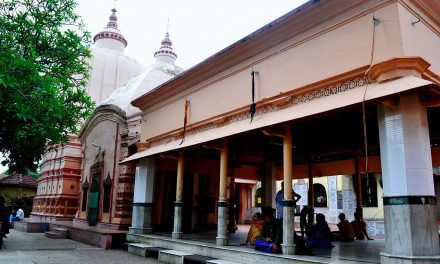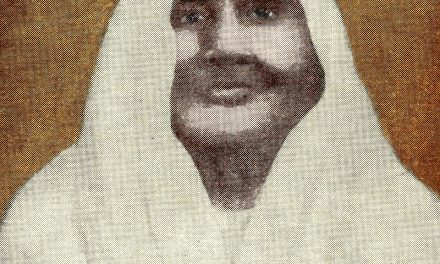It is indeed very tough for me to keep away myself from inscribing a few words about the Hindu feminine divinity. Hence, to continue my spiritual habit, I am eager to bring into the limelight one of the anecdotes oriented with Hindu feminine divinity that conveys the mythology related to yajna arranged by Prajapati King Daksha. Yes, one of fifty-one shaktipeethas(as per Devi Purana) came into being as ‘Vimla or Kiriteshwari’ Temple, located at Kiritkona(also spelt as Kireetkona) village under the Nabagram CD block in the Lalbag subdivision of Murshidabad district in West Bengal.
The term-times when ‘Satya Yuga'(the first of the four eras) was passing through and remarked with an incident of ‘Daksha Yajna’. King Daksha had invited the gods and goddesses, sages and kings, who all were peers to him with their dignities. In contrast, Daksha deliberately neglected his younger daughter Sati and Her beloved consort Lord Shiva refusing to invite them to that auspicious and religious ceremony. But She was Devi Sati who could not control herself to attend that yajna organised by her father, although Lord Shiva was the only person who tried his best to discourage Her. But Devi Sati did not hear him and did so whatever She desired. As a result, She had to digest a lot of slang rushed towards her spouse Lord Shiva and herself in front of all the dignitaries. Devi Sati was not exceptional, and it was tough to digest this embarrassing situation. She had nothing to decide to immolate herself into the same yajna pit(religious sacrificial altar). The onlookers tried a lot to rescue Her, but it was too late, and they could only pull out her burnt-dead body. Lord Shiva quickly learned about the mishap and plunged himself into mourning for a few moments. But he could strongly rid of this emotional periphery and activate his third eye from where his embodiment, ‘Veerbhadra’, was sent to dilapidate the yajna place and decapitate the king Daksha.
The assignment was duly performed as it was directed. Next, the embodiment toured the entire universe with the corpse of Devi Sati with a mere motto of the destruction of the same. All the gods and goddesses felt very helpless and had recourse to another Lord ‘Vishnu’ to save the entire creation. Lord Vishnu severed the corpse of Devi Sati with his ‘Sudarshan Chakra'(disc of auspicious vision). It was counted fifty-one pieces with her ornaments and wearings, which fell on the Indian subcontinent. The crown, Kirit, or mukut of Devi Sati have fallen here to make this a holy place, subsequently familiarised as ‘Kiriteshwari Temple’. For that, it is also considered a uppeetha by a few.
History that the temple conveys behind its establishment: As we know, Murshidabad district lies with a remarkable history that makes it rich in the history of Bengal, especially the reign of the Muslims has made this district as well Bengal famed on the map of India. This district has also been enriched with a handful of Hindu temples; among them, Kiriteshwari Temple is the oldest. It is a historical record that the original temple of Maa Kiriteshwari was reerected by Darpanarayan Roy, the late king of Lalgola, in the 19th century where the original temple was destroyed in the year 1405 due to a devastating fire or with the continuous Muslim invasions or it may be with the coming of British. Another source says that it was Bhagwan Roy(descendant of Darpanarayan Roy), who the Mughal emperor gave one piece of land, Akbar, on which he, with the assistance of his few followers, built the temple which had its entrance toward the south. At the same time, the new construction facing the east was built by Maharaj Darpanarayan Roy. Later, Yogendranarayan Roy, the late king of Lalgola, was responsible for renovating and caring for the temple. The goddess Kiriteshwari was considered and declared the presiding deity of the ruling families(probably one of them was the Roy family of Cossimbazar), located near Murshidabad(previously known as Mukshudabad and the then capital of Bengal, Bihar and Orissa and seat of the Nawabs).
Legends that made this temple famous
It is a hearsay that Mir Jafar, the notorious betrayer of ancient Bengal political history, prayed to have the charanamrit(holy water) made from the great bathing water of Maa Kiriteshwari on his death bed, shabbily suffering from leprosy.
Another incident encloses the temple as a legend with Tara, the daughter of Rani Bhawani(also known as Ardhabaneshwari or Natorer Rani or the Queen of Natore, was a Hindu zamindar during the British colonial era, now in Rajshahi, Bangladesh). Maa Vimala rescued Tara from Siraj-ud-Daulla, the Nawab of Bengal when he considered her(Tara) as his prey for evil wishes. Tara was neglected atrociously by Siraj-ud-Daulla when she was suffering from smallpox. However, Tara recovered later within a few days with the blessings of Maa Vimala or Kiriteshwari. It is said that Mangal Vaishnav, a contemporary of Shree Chaitanya Mahaprabhu, was a shebait of that temple while the goddess was worshipped by hundreds of devotees every day.
About the architecture and the deities of the temple
This masonry of Bengal has completed its age of more than a thousand years with traditional terracotta red, a classic example of a Bengal Shakti Peeth. This one-storied edifice is a reflection of simple ornamentation. The sanctum sanctorum does not have any image of a deity except a red-coloured stone which is a symbolic representation of the goddess, covered with a red-coloured veil throughout the year. Inside the sanctum sanctorum, there is a high altar on which a small altar is seen, and the face of Mother Vimala is incorporated. The crown of Devi Sati is preserved at the Rani Bhawani’s Guptamath. The Kiriteshwari Temple is a small shrine under a charchala pattern of architecture. This temple was previously known as ‘Kireetkona’, which is mentioned in the ‘Vabisyapuran’, literature written in the medieval period. In this temple complex, sixteen temples of different deities presently dwell here. Local people call this temple ‘Mahishamardini’. Here the deity is also worshipped as ‘Mukuteshwari Temple’ as the ‘mukut or Kirit or crown’ of Devi Sati fell here. It is heard through a source that this temple existed in the time of Shankaracharya(an Indian Vedic scholar and teacher) and the Gupta age. Here in this temple, Peeth devi’s name is Devi Vimala, and Bhairav is ‘Samvarta’. A few minutes from the main temple, the Bhairav Temple is located by the bank of River Bhagirathi, and this temple needs to be better maintained and remained locked for hours.
Worshipping: The red stone wrapped with a red veil is worshipped as a replica of the goddess since there is no image or idol inside the sanctum. Only on Durga Ashtami the old veil is unwrapped yearly, and the deity is bathed. After that, the stone is again wrapped with a new one. Daily worshipping by the temple priests starts at 6:00 a.m. To satisfy the goddess, She is offered fruits, flowers, incense and diyas by the priests and the devotees. At noon She is served Anna Bhoga(prepared with rice, lentils and vegetables), sweet dishes like payasam(made with boiling milk, sugar or jaggery and rice) and many more. The pilgrims are blessed with the Prasad(grace) of Maa Kiriteshwari and Her Bhairav.
Besides the daily worshipping, the Hindu temple priests hold special worshippings on all Amavasya (no moon). Not only that, on every new moon, a special ritual is performed in the name of the Goddess Kiriteshwari. Yajnas are also performed for the whole night. The goddess is offered fruits and sweets and ornamented with fresh garlands and flowers. A special bhog(rice food) is prepared to contribute to the Goddess Kiriteshwari during this time.
Festivities that are held in the temple
Major festivals that are performed with pomp in this temple are Mahashivratri(in the English month of March), Durga Puja, Vijayadashami and Navratri(in the English month of October) and Kali Puja(in the English month of November). Kiriteshwari Mela, a local fair, is held here from December to January every Tuesday and Saturday by the western bank of the Bhagirathi river.
visiting time for the pilgrims: 6:00 a.m. to 3:00 p.m.(first shift) and 5:00 p.m. to 10:00 p.m.(second shift)
Postal address: Village: Kiritkona, P.O.: Kiriteshwari, P.S.: Nabagram, District: Murshidabad, West Bengal, Pin: 742104.
How to reach: Three modes of communication are available to reach the temple, which is as follows:
By Air: The nearest airport is Netaji Subhash Chandra Bose International Airport. From there, Murshidabad is 195 km away, and the Kiriteshwari Temple is 239 km away. From the airport, taxi services are available for Murshidabad.
By Railway: Murshidabad railway station is connected by train to Howrah and the major cities of India. The nearest railway station is Dahapara, which is 3.2 km away from the temple.
By Road: Murshidabad is well connected by road. From Kolkata, Burdwan, Rampurhat, Siuri, Bolpur, Malda, Krishnanagar and Durgapur, state-run buses ply daily to Murshidabad. The nearest bus stand is Dahapara. Taxis are also available from the places mentioned above.
Image Courtesy: Hindu Temples-India
















